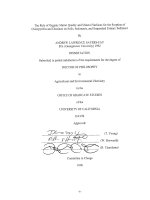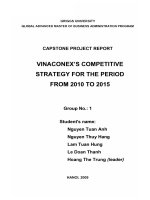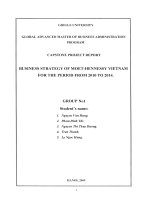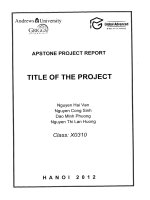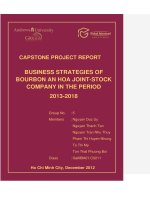Business strategy of Viet Phu foods and fish corporation for the period from 2012 to 2016
Bạn đang xem bản rút gọn của tài liệu. Xem và tải ngay bản đầy đủ của tài liệu tại đây (3.17 MB, 95 trang )
Capstone Project report – Group 9 – C0310
1
GLOBAL ADVANCED MASTER OF BUSINESS
ADMINISTRATION PRORGAM
CAPSTONE PROJECT REPORT
TOPIC:
BUSINESS STRATEGY OF VIET
PHU FOODS AND FISH
CORPORATION FOR THE PERIOD
FROM 2012 TO 2016
Class: C0310
Group 9:
1. Truong Ngoc Anh Linh (Team leader)
2. Ha Trong Diep
3. Nguyen Thi Thanh Mai
4. Tran Tan Nhat
Ho-Chi-Minh City – March 2012
Capstone Project report – Group 9 – C0310
2
ACKNOWLEDGEMENTS
I would like to acknowledge and extend my heartfelt gratitude to the following
persons who have made the completion of this research paper possible:
All professors and lecturers whose encouragement, guidance and support from the
initial to the final level enabled me to develop an understanding of the subject.
ETC Hanoi National University for the convenience and support provided.
Board of Management of Viet Phu Corporation for assisting in the collection of data
and any explanation needed.
Most especially to my family and friends.
Lastly, I offer my regards and blessings to all of those who supported me in any
respect during the completion of the research.
Ho-Chi-Minh City, March 2012
Group 9- Class GaMBAC0310
Capstone Project report – Group 9 – C0310
3
Capstone Project report – Group 9 – C0310
4
CONTENTS
LISTS OF TABLES 9
PART I: GENERAL INTRODUCTION 12
1. Reason for choosing topic: 12
2. Objectives of research and possible application 12
2.1. General objective 12
2.2. Specific objective 12
2.3. Applicability: 13
3. Research content: 13
4. Research method: 13
4.1. Data collection method: 13
4.2. Data analysis method: 13
5. Object and scale for research 14
5.1. Research object: 14
5.2. Research scale: 14
5.2.1. Space: 14
5.2.2. Time: 14
5.2.3. Content structure of this topic: including 3 chapters 14
PART II: CONTENT 16
CHAPTER I: LITERATURE REVIEW 16
1.1. The concept of strategy and strategic management 16
1.1.1. The concept of strategy: 16
1.1.2. The concept of strategic management: 16
1.2. Strategic management process: 16
1.2.1. Planning strategy stage: 17
1.2.2. Implementation stage of strategy: 18
1.2.3. Evaluation stage of strategy: 18
1.3. Business environment’s factors: 18
1.4. The tools for developing and choosing strategy: 19
Capstone Project report – Group 9 – C0310
5
1.4.1. Internal Factor Evaluation (IFE): 19
1.4.2. External Factor Evaluation (EFE): 20
1.4.3. Competitive Profile matrix: 20
1.4.4. SWOT matrix: 21
1.4.5. Strategic Position & Action Evaluation (SPACE) 22
1.4.6. Quantitative Strategic Planning Matrix (QSPM): 23
1.5. The role of strategic management for the development of business 23
1.6. Model of 5 competitive pressures by Michael Porter 24
1.6.1. Supplier’s competitive pressure: 24
1.6.2. Customer’s competitive pressure: 24
1.6.3. Competitive pressure from potential competitors: 25
1.6.4. Competitive pressure from substitute products: 26
1.6.5. Competitive pressure from internal industry: 26
CHAPTER 2: OVERVIEW AND SITUATION ANALYSIS OF VIET PHU
FOODS AND FISH CORPORATION 28
2.1. Overview of fishery, difficulties and challenges: 28
2.2. Overview of VIET PHU FOODS AND FISH CORPORATION 31
2.2.1. History and development of the Company 31
2.2.2. Major business lines: 32
2.2.3. Structure 33
2.2.4. Tasks - functions of the division department 33
2.4. Analysis – limitations, existence of Vie Phu Corp in the period of 2007-
2011. 38
2.4.1. Analysis of internal factors 38
2.4.1.1. Administration 38
2.4.1.2. Functions of human resource 39
2.4.1.3. Production activities - Operation 41
2.4.1.4. Marketing activities 43
2.4.1.5. Financial activities – Accounting 44
2.4.1.6. Research activities and development 46
2.4.1.7. Information Systems 46
2.4.2. Analyzing the external factors 46
Capstone Project report – Group 9 – C0310
6
2.4.2.1. Economic factors 46
2.4.2.2. Elements of law, government and politics 48
2.4.2.3. Cultural factors - social – demographic 49
2.4.2.4. Scientific factors – technology 50
2.4.2.5. Natural factors 50
2.4.2.6. Environmental industries 51
a) The pressure from competitors 51
b) Competitive pressure from customers 53
c) Pressure from suppliers 54
d) Hidden new competitors 55
e) Pressure from substitute products 57
CHAPTER III: BUSINESS DEVELOPMENT STRATEGY OF VIET PHU
FOODS & FISH CORPORATION 62
3.1. Objectives of in the Company for the period from 2012 to 2016 62
3.1.1. Definition of objectives: 62
3.1.2. Objectives of the Company 63
3.2. Application of strategic planning matrices of the Company 64
3.2.1. External Factor Evaluation (EFE) 64
3.2.2. Internal Factor Evaluation (IFE) 65
3.2.3. Competitive profile Matrix (CPM): 66
3.2.4. SWOT analysis matrix 66
3.2.4.1. Group S-O strategy: 69
3.2.4.2. Group S-T strategy: 69
3.2.4.3. Group W-O strategy: 69
3.2.4.4. Group W-T strategy: 69
3.2.5. Strategic Position & Action Evalution (SPACE) 69
3.2.6. Quantitative Strategic Planning Matrix (QSPM) 71
3.2.6.1. QSPM Matrix group S-O 71
3.2.6.2. QSPM Matrix group W-O 72
3.2.6.3. QSPM Matrix group S-T 73
3.2.6.4. QSPM Matrix group W-T 75
Capstone Project report – Group 9 – C0310
7
3.2.7. Strategic choices consistent with the operational objectives of Viet Phu to
2016. 76
3.3. Recommendations for the Company to implement of the selected strategies 76
3.3.1 Marketing strategies 76
3.3.1.1 Product 76
3.3.1.2 Price 77
3.3.1.3 Place 78
3.3.1.4 Promotion 78
3.3.2 Production strategy 79
3.3.2.1 Concentrate on profitable commodities 79
3.3.2.2 Stability of raw material supplies 79
3.3.2.3 Reduction of production costs 80
3.3.2.4 Improvement of production technology 82
3.3.2.5 Enhance quality control 82
3.3.3 Financial strategies 83
3.4 For the Vietnamese Government and other related organisations 84
CONCLUSION 86
REFERENCES 88
APPENDICES 89
Capstone Project report – Group 9 – C0310
8
LISTS OF TABLES
Table 2- 1: Qualifications of the workforce 39
Table 2- 2: The basic financial indicators 44
Table 2-3: Tra and Basa pricefluctuate from 2009 to 2011 53
Table 2-4: Financial indicators 60
Table 3-1: Viet Phu’s External Factor Evaluation matrix 63
Table 3-2: Viet Phu’s Internal Factor Evaluation Matrix 64
Table 3-3: Viet Phu’s Competitive Profile Matrix 65
Table 3-4: Viet Phu’s SWOT analysis 66
Table 3-5: VietPhu’s SPACE 68
Table 3-6: QSPM Matrix group S-O 70
Table 3-7: QSPM Matrix group W-O 71
Table 3- 8: QSPM Matrix group S-T 72
Table 3- 9: QSPM Matrix group W-T 74
Table 3-10: COMPARISON OF FISH AQUACULTURE EXPENSES 79
Table 3-11: Forecast for the period from 2012 to 2016 83
Capstone Project report – Group 9 – C0310
9
LISTS OF FIGURES
Figure 2-1: Main Markets of sea products in 2011 26
Figure 2-2: Main products of aquatic industry in 2011 27
Figure 2-3: Perforamnce of Viet Phu in the period of 2007-2011 36
Figure 2-4: VietPhu’s market 43
Figure 2-5: Fish-export market share of the businesses in 2011 51
Figure 2-6: Export value of catfishes in 2007-2011 56
Capstone Project report – Group 9 – C0310
10
LIST OF ABBREVIATIONS
HACCP: Hazard Analysis and Critical Control Point System
BRC: British Retailer Consortium (BRC Gobal Standard for Food Safety)
GMP: Good Manufacturing Pratice
ISO: The International Organization for Standardization
Global GAP: Global Good Agricultural Practices
VASEP: The Vietnam Association of Seafood Exporters and Producers
WTO: World Trade Organization
EU: European Union
DOC: United States Department Of Commerce
IFE: Internal Factor Evaluation
EFE: External Factor Evaluation
SWOT: Strengths, Weaknesses, Opportunities and Threats
SPACE Strategic Position & ACtion Evalution
BCG Boston Consulting Group Matrix
QSPM: Quantitative Strategic Planning Matrix
CPM: Competitive Profile Matrix
GDP: Gross Domestic Product
VND: Vietnam Dong
USD: United States Dollar
WWF: World Wide Fund
ASC: Aquaculture Stewardship Council
Capstone Project report – Group 9 – C0310
11
PART I: GENERAL INTRODUCTION
1. Reason for choosing topic:
Fisheries industry is one of the key sectors in the industrialization and
modernization of Vietnam which has a number of competitive advantages to be
developed including abundant resources, cheap labor cost and preferential
encouraging policies of the Government. The continuously significant growth of the
Vietnamese seafood industry for years, especially the current exported achievement
in 2011 of US$6.1 billion which was triple increased over 10 years of development,
provides the strong evidence for its bright future prospects. However, while the high
world demand gives great opportunities and a large playing field for all, the trade
barriers, harsh competition and a number of problems and challenges are always big
concerns for all Vietnamese seafood exporters, especially for small and medium size
companies with limited resources. As a result, determining right developing
strategies to pursue becomes so vital and inevitable for Vietnamese seafood
exporters in surviving, developing and determining their position in domestic and
international markets. For that reason, this study aims to critically assess and deeply
analyse the current operation of Viet Phu Food Fish Corporation (“the Company”)
to identify its current achievements and difficulties facing the Company then
recommend practical and effective business strategies that the Company should
implement to improve and enhance its current position for the period from 2012 to
2016.
2. Objectives of research and possible application
2.1. General objective
Evaluating the effectiveness of production and business operations at the
company from 2007 to 2011 to discover the advantages and disadvantages of the
company, besides understanding and analyzing about strength, weaknesses,
opportunities, thread, external and internal environment that company has to face.
Through them, analyzing and building business strategy for Viet Phu in the future.
2.2. Specific objective
Capstone Project report – Group 9 – C0310
12
- Learning about company’s general circumstance:
Carrying out analysis of revenues, expenses, profits, the business performance
indicators and financial ratios of the company over 05 years (2007-2011) to evaluate
company’s business results and evaluate overview of Vietnam aquatic product
sector.
- Analyzing factors which affects company’s business operation.
- Giving the solutions to overcome difficulties, to promote the advantages of the
company and to develop business strategies for company.
2.3. Applicability:
Developing business strategy to help companies assess itself the strengths,
weaknesses to fix and improve. Additionally it can help the company to prove all
potentiality and to exploit all resources to achieve the highest efficiency in business.
Besides, the act of company’s building business strategy can prevent and limit the
risks of business which can also predict business conditions in the near future.
3. Research content:
Generally introduce about the process of company’s development,
organizational structure and business situation in recent years. Then carry out the
analysis of internal factors to draw strengths and weaknesses of the company, the
micro and macro of factors impact on industry and company to realize the
opportunities which company can make use of and should be avoided. From them,
building the business strategy can be applied to the Company.
4. Research method:
4.1. Data collection method:
- Directly collect data from Viet Phu
- Consult data from books, websites and the knowledge have learned
4.2. Data analysis method:
*Comparative method:
Capstone Project report – Group 9 – C0310
13
Using this method to compare and evaluate data analysis and be mainly used
to serve in the analysis of financial ratios. From the collected data, the team draws a
comparison between the years and this method clearly shows the change in
company’s capability and business situation over the reporting period.
*Ratio method:
Ratio method is used to show that the change percentage’s rate of this period
compared to the previous period or original period, reflecting the growth or
stagnation in business. Generally this method is used to combine with the
comparative method. Sometimes it’s also known as the relative method. This is a
fairly simple method to analyze the changes on company’s financial situation
objectively.
5. Object and scale for research
5.1. Research object:
Because of limited ability, our group just focuses on factors’ study which
affects the production and business ability of the company, and through them we
build business strategy for the company. When analyzing company’s financial status
and performance, our group primarily based on the analysis of financial ratio,
balance sheet, statement of business results, employment interview, reference books,
essays of aquatic product industry and enterprises in same business.
5.2. Research scale:
5.2.1. Space:
The research is done on the basis of the information and data at Viet Phu
Foods and Fish Corporation.
5.2.2. Time:
The analytical data has been synthesized through 5 years of 2007-2011.
Execution time of this topic is from Dec 2011 to Feb 2012.
5.2.3. Content structure of this topic: including 3 chapters
Capstone Project report – Group 9 – C0310
14
- Chapter 1: Literature review
- Chapter 2: Overview and situation analysis of Viet Phu Foods and Fish
Corporation.
- Chapter 3: Strategy and solution planning
Capstone Project report – Group 9 – C0310
15
PART II: CONTENT
CHAPTER I: LITERATURE REVIEW
1.1. The concept of strategy and strategic management
1.1.1. The concept of strategy:
The strategy is a set of goals and policies as well as main plans to achieve
these goals. It clearly shows that what the company is or will perform which
business activities.
With a company, a strategy is like a decisions system to establish the goals or
milestones that company must do. It sets out the policy and plan to implement
objectives. It identifies business form and ideas of the Company, nature of the
economic contributions and outside the scope of economy which company can do
because of company’s employee and society.
1.1.2. The concept of strategic management:
Strategic management is the process of researching present environment as
well as future; planning objectives of the organization; carrying out to implement
and to supervise the implementation of decisions for achieving objectives in present
and future environment.
1.2. Strategic management process:
Strategic management process includes three stages: planning strategy,
implementing strategy and evaluating strategy.
Capstone Project report – Group 9 – C0310
16
(Source: Fredr. David – Outline of strategic administration)
Figure: Overall strategic administration
1.2.1. Planning strategy stage:
Strategic planning is the process of establishing and developing business
tasks, carrying out investigation and research to identify opportunities and threats to
the organization from outside, showing the inside of strengths and weaknesses,
setting long-term objectives, creating and selecting alternative strategies and
specific strategies to pursue.
Three basic operations in strategic planning are to do research, to be in
harmony with the intuitive analysis and to draw conclusions.
Doing research associated with collecting and processing information about
the external –internal environment and current internal strength of organization.
After synthesizing the information gathered, we will rely on to assess, to arrange
ơ
Allocate
resourc
es
Redetermine
business
goals
Analyze internal
goals. Identify the
strengths and
weaknesses.
ơ
Select
appropri
ate
strategy
ơ
Adopt
policy
Formation of strategy Implementation Quality evalua
tion Evaluation
Vision,
role, and
strategic
goals
Analyze external
conditions,
determine
opportunities
and risks
Measure
and
evaluate
the
implement
ation of the
strategy
ơ
Set out
long
term
goals
ơ
Set out
annual
goals
Capstone Project report – Group 9 – C0310
17
and to combine these threats and important opportunities of the outside with the
strengths and weaknesses within the organization to carry out possible strategies for
the organization a complete strategy.
1.2.2. Implementation stage of strategy:
Implementation of strategy is a critical and difficult stage in the process of
implementing strategic management.
This is the action stage of strategic management. Implementation stage of
strategy requires organizations to set short term objectives, bringing out policies and
allocation of resources, changing the current organizational structure
1.2.3. Evaluation stage of strategy:
This is the final stage of the strategic management. Strategic evaluation is the
process of reviewing the basis and objectives for the current strategy, monitoring the
results of established operation and implementing strategy, comparing achieved
results with targets and determining the cause of deviations and making corrective
action.
Evaluation process is necessary because a successful strategy can bring long
term benefits and significant or in the contrast it can bring a serious disadvantage.
The timely assessment can help organizations to identify gaps or mistakes in
the implementation and finish process. Thereby, the organization can exactly know
their strategy’s effectiveness and accumulate the necessary experience.
1.3. Business environment’s factors:
The analysis of business environment’s factors is very important because we
can determine the basis for developing strategies and these factors have great
influence on all subsequent steps of the process of implementing the strategy.
The business environment is divided into three levels: internal environment,
macro environment (industry environment) and micro-environment.
Capstone Project report – Group 9 – C0310
18
Internal environment includes all resources of organization. For the act of
developing business strategy, we need to analyze the internal environment to see
clearly strengths and weaknesses. Basing on that basis we bring out solution to limit
the downside and to prove strength for gaining the maximum advantage.
The main elements of the internal environment include: management, marketing,
finance - accounting, manufacturing, research - development and human resources.
Industry environment includes factors in industry which organization decides the
nature and extent of competition in business. There are 5 basic elements of industry
environment: suppliers, customers, competitors, new competitors and substitutes.
Macro environment includes factors outside the organization which shapes and
affects the industry environment and internal environment and it also creates the
opportunities and risks for organizations. Macro environment includes the basic
elements: economy, culture - society - demographic, politic- law, nature and science
- technology. Each factor can independently affect organization or work in
conjunction with other factors.
Macro environment and industry environment combine together referred to as
the external environment. Each element of the external environment or the
alignment of them can be opportunity or threat for organizations. Through analysis
of them, organization can determine opportunities which they can leverage and the
risks that you should avoid.
1.4. The tools for developing and choosing strategy:
1.4.1. Internal Factor Evaluation (IFE):
The internal situation of the enterprise is usually evaluated through functional
division such as Finance, Human Resources, Operation Management, Organization
Structure, Marketing, Information Technology, etc. The internal analysis of
business will help to identify business’ strengths (S) and weaknesses (W). Through
them, to choose appreciate business strategy.
Capstone Project report – Group 9 – C0310
19
The evaluation of internal factors’ study is very important and an integral part
of strategic management. If administrators do not research internal environment of
business, can not figure out the strengths and weaknesses of the business correctly.
Therefore they can not come up with a perfect strategy.
1.4.2. External Factor Evaluation (EFE):
An organization’s environment is the factors, forces and institutions outside
the business that administrators can not control but they have tremendous impact to
operation and performance of the business.
The external environment of organizations can be divided into two levels:
- Macro environment: affects all business field such as the economic environment,
legal environment, social and cultural environment.
- Micro Environment (also known as the industry environment) was determined for
each specific occupation. It includes such factors as: (1) competitors, (2) customers,
(3) suppliers, (4) potential rivals, (5) substitutes
- Analysis of external environment factors will help businesses to identify clearly
what are the opportunities (O) and the challenges which they have to face.
1.4.3. Competitive Profile matrix:
Competitive Profile matrix (CPM) implies impact of factors which affect to
nature decision and extent of organization’s competition in the business industry.
CPM identifies main competitors with the strengths and weaknesses of their special.
The external factors when developing CPM are cared: suppliers, customers,
competitors, substitutes and potential rivals. CPM also includes some internal
elements which is the most important decision of the organizational success when
comparing to competitors. Replying on analysis of these factors, we can draw the
advantages and disadvantages of competitors compared with the organization. That
is, CPM is the synthesis of the impact of comparative factors both inside and outside
of the organization.
Capstone Project report – Group 9 – C0310
20
1.4.4. SWOT matrix:
SWOT analysis is a very useful tool to understand and to make decisions
within any situation for any organization. 4-digit stands for Strengths (strong
points), Weaknesses, Opportunities and Threats. SWOT provides a strategic analysis
to review and to evaluate the position and orientation of a company or a business
plan. SWOT is suitable for working and analyzing in groups, be used in business
planning, strategy, competitors’ evaluation, marketing, product development and
service.
Strengths and weaknesses is the internal factors of the company.
Opportunities and Threats are external factors that impact the SWOT analysis with
different factors and they influence the relative competitiveness of the company.
SWOT usually combined with PEST (Political, Economic, Social, Technological
analysis), market analysis’ model and evaluation of market potential through
external factors in terms of politic, economy, society and technology. Analyzing
according to SWOT analysis model is the evaluation of the data which are arranged
in form of SWOT as a logical order to help readers to understand, to present and to
arrive at the decision easier.
- SWOT Matrix: a tool combining the strengths (S), weaknesses (W), opportunities
(O) and threats (T) to form four types of strategies such as the following table.
S
List Strengths
W
List Weaknesses
O
List Opportunities
S-O Strategies
W-O Strategies
T
List of Threats
S-T Strategies
W-T Strategies
To create a SWOT matrix administrator must implement the 08 steps as follows:
Step 1: List the main opportunities from the external environment (O1, O2 )
Step 2: List the main threats from the external environment (T1, T2 )
Capstone Project report – Group 9 – C0310
21
Step 3: List the main strengths of the business (S1, S2 )
Step 4: List the key weakness of the enterprise (W1, W2 )
Step 5: Combine the strengths with opportunities (SO)
Step 6: Combine the weaknesses with the opportunities (WO)
Step 7: Combine the strengths with threats (SO)
Step 8: Combine the weaknesses with threats (WT)
The purpose of SWOT matrix is to set out feasible strategies which can be chosen,
not decide what is the best strategy. Therefore one of development’s strategies in the
SWOT matrix, only some of the best strategy is selected for implementation.
1.4.5. Strategic Position & Action Evaluation (SPACE)
The strategic Position and Action Evaluation matrix is a management tool to
be used to analyze the strategy. It is used to determine which strategy the company
should do.
Figure: SPACE matrix
FS
ES
CA
Aggressive
Conservative
Defensive
Competitive
+6
+5
+4
+3
+2
+1
-1
-2
-3
-4
-5
-6
+1 +2 +3 +4 +5 +6
-6 -5 -4 -3 -2 -1
IS
Capstone Project report – Group 9 – C0310
22
Original frame of this picture shows offensive strategy, cautiousness, defensiveness
or competition are most suitable for a certain organization. The axes of the SPACE
Matrix represent two aspects within the organization (financial strength [FS] and
competitive advantage [CA]) and two external dimensions (environmental stability
[ES] and industry strength [IS]). These four factors are the most important decisions
for general strategic position of an organization.
1.4.6. Quantitative Strategic Planning Matrix (QSPM):
QSPM matrix (Quantitative Strategic Planning Matrix) is a tool that permits
strategists to objectively evaluate substitutable strategies, firstly basing on the key
success factors of the inside and outside defined. Like the other analysis of
establishing strategy, QSPM matrix requires good judgment by intuition.
1.5. The role of strategic management for the development of business
According to Garry D. Smith and other authors, strategic management affects
as follow:
(1) Helping organizations to find their purpose and direction. Recognizing the
desired results and future goals helps both leaders and employees to
understand what needs to be done to achieve success. Therefore it will
encourage both above groups get the short term achievements to better long-
term welfare’s company.
(2) Environmental conditions, which organization has to face, quickly changes
and they often create surprised things. Strategic management helps
administrators to clearly see environmental conditions in the future. Basing
on these conditions, they can better grasp and take advantage of opportunities
as well as reduce risks.
(3) Helping companies to associate the definite decisions with relevant
environmental conditions, thereby accounting for active position or passive
attacks.
Capstone Project report – Group 9 – C0310
23
(4) The most important reason to apply strategic management is almost
companies’ study shows that businesses, which are using strategic
management, can achieve results better than the previous results when
comparing with the results of companies do not.
1.6. Model of 5 competitive pressures by Michael Porter
1.6.1. Supplier’s competitive pressure:
Supplier’s quantity and size: Supplier’s quantity will decide competitive
pressure and negotiation power for industry and business. . If there are a few
suppliers with large size, they will create competitive pressure which affects the
entire business activities of the sector.
Substitutable products of supplier: In this issue we study the possibility of
replacing the inputs from suppliers and switching cost of supplier.
Supplier’s information: In the current era, information is always a factor
which promotes the commercial development and supplier’s information influences
on selecting input suppliers for business.
For all the industry, suppliers always cause the certain pressure if they have
scale, aggregate and the possession of precious resources. Therefore retail suppliers
of input products, such as farmers and artisans, will have little negotiation power
with businesses despite the large quantity but lacks of organization.
1.6.2. Customer’s competitive pressure:
Customer is a competitive pressure which can directly affect the entire
business activities of the sector.
Customer can be divided into 2 groups:
+ Retail customer
+ Distributor
Capstone Project report – Group 9 – C0310
24
Both groups pressure company into price, product quality and attached
service and they are controller of competition in industry through the purchase
decision.
Similar to pressure from suppliers we consider the impact on the competitive
pressure from customers for industry.
+ Size
+ Importance
+ Switching cost of customer
+ Customer profile
Especially when analyzing distributors we have to pay attention to their
importance because they can directly bully in internal enterprise.
1.6.3. Competitive pressure from potential competitors:
According to M-Porter potential competitors are businesses which are
currently unavailable in the industry but they may affect the industry in the future.
Potential competitors are more or less, their pressure for industry is strong or weak.
All will depend on the following factors:
+ The attractiveness of the industry: This factor is reflected by indicators
such as interest rate, the number of customers and enterprises in the industry.
+ Barriers of joining industry: are factors which make business entered in
industry more difficult and expensive.
1. Technique
2. Capital
3. Commercial elements: Distribution system, brand and customer
system,
4. Particular resources: input materials, degree, patents, human
resources, Government protection.
Capstone Project report – Group 9 – C0310
25
1.6.4. Competitive pressure from substitute products:
Substitute products and services are the products or services which can
satisfy the same need in the industry.
Main competitive pressure of substitute products is the ability to meet
demand compared to other products in the same industry. In addition, factors of
price, quality and other environmental factors such as culture, politics, technology,
they will also affect the threat of substitute products.
Sudden nature, unpredictability of substitute products: With the development
of technology can create substitute products for their own sector even internal
industry. Mobile phone is substitute product for fixed telephone and VOIP will
replace both of them in the near future.
Switching cost: We know the open source software like Linux or Viet Key
Linux in Vietnam with very cheap price or even free. But very few people use them
because the cost of switching from Windows operating systems and applications to
the other operating systems can be very high and affect the operation as well as the
work on the computer.
1.6.5. Competitive pressure from internal industry:
Businesses are trading in the same industry, which directly compete each
other and create return of pressure on industry, will create a competitive intense. In
the same industry, these following factors will increase competitive pressure on
competitors.
+ Industry status: demand, growth rate, the number of competitors
+ Industry structure: concentration or dispersion
Dispersive industry is an industry has many businesses which compete
with each other but there is not business which can control the remaining
companies.


